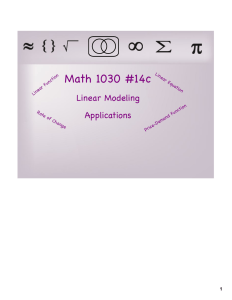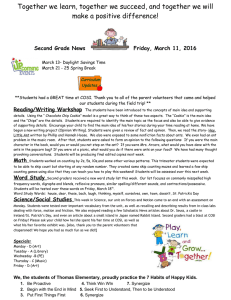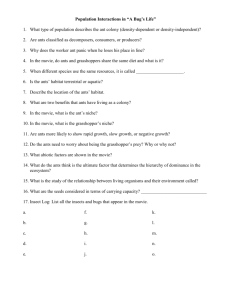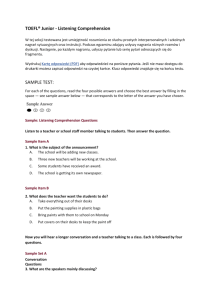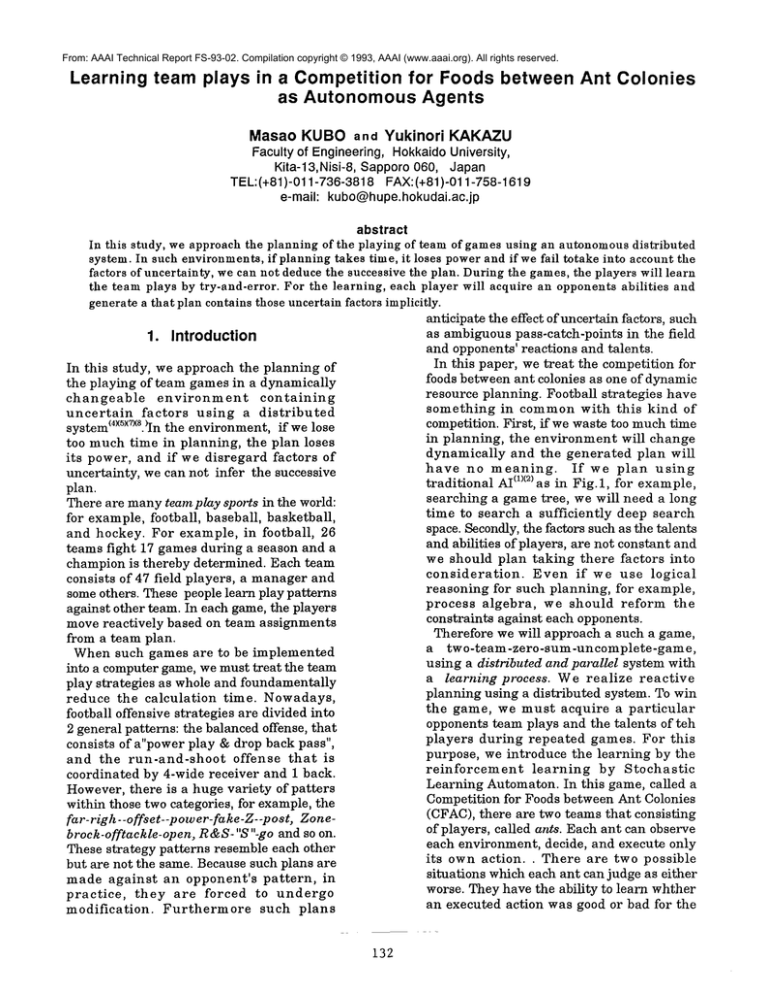
From: AAAI Technical Report FS-93-02. Compilation copyright © 1993, AAAI (www.aaai.org). All rights reserved.
Learning team plays in a Competition for Foods between Ant Colonies
as Autonomous Agents
MasaoKUBOand Yukinori KAKAZU
Facultyof Engineering,
Hokkaido
University,
Kita-13,Nisi-8, Sapporo060, Japan
TEL: (+81)-011-736-3818FAX: (+81)-011-758-1619
e-mail: kubo@hupe.hokudai.ac.jp
abstract
In this study, we approachthe planning of the playing of team of gamesusing an autonomousdistributed
system. In such environments, if planning takes time, it loses power and if we fail totake into account the
factors of uncertainty, we can not deduce the successive the plan. Duringthe games,the players will learn
the team plays by try-and-error. For the learning, each player will acquire an opponents abilities and
generate a that plan contains those uncertain factors implicitly.
anticipate the effect of uncertain factors, such
as
ambiguous pass-catch-points in the field
1. Introduction
and opponents’ reactions and talents.
In this paper, we treat the competition for
In this study, we approach the planning of
foods
between ant colonies as one of dynamic
the playing of team games in a dyn-mically
resource
planning. Football strategies have
changeable
environment
containing
something
in common with this kind of
uncertain
factors
using a distributed
competition. First, if we waste too much~me
system(4Xs×Txs.>Inthe environment, if we lose
in planning, the environment will change
too much time in planning, the plan loses
dynamically and the generated plan will
its power, and if we disregard factors of
have
no meaning.
If we plan using
uncertainty, we can not infer the successive
(1X~° as in Fig.l, for example,
traditional
AI
plan.
searching a game tree, we will need a long
There are manyteam play sports in the world:
time to search a sufficiently
deep search
for example, football, baseball, basketball,
space.
Secondly,
the
factors
such
as
the talents
and hockey. For example, in football,
26
and
abilities
of
players,
are
not
constant
and
teams fight 17 games during a season and a
we
should
plan
taking
there
factors
into
champion is thereby determined. Each team
consideration.
Even if we use logical
consists of 47 field players, a manager and
reasoning
for
such
planning, for example,
someothers. These people learn play patterns
process
algebra,
we
should reform the
against other team. In each game, the players
constraints
against
each
opponents.
move reactively based on team assignments
Therefore
we
will
approach
a such a game,
from a team plan.
a
two-team-zero-sum-uncomplete-game,
When such games are to be implemented
using a distributed and parallel system with
into a computer game, we must treat the team
a learning process. We realize reactive
play strategies as whole and foundamentally
planning using a distributed system. To win
reduce the calculation
time. Nowadays,
the game, we must acquire a particular
football offensive strategies are divided into
opponents team plays and the talents of teh
2 general patterns: the balanced offense, that
players during repeated games. For this
consists of a"power play & drop back pass",
purpose, we introduce the learning by the
and the run-and-shoot
offense that is
reinforcement
learning
by Stochastic
coordinated by 4-wide receiver and 1 back.
Learning
Automaton.
In
this
game, called a
However, there is a huge variety of patters
Competition
for
Foods
between
Ant Colonies
within those two categories, for example, the
(CFAC),
there
are
two
teams
that
consisting
far-righ--offset--power-fake-Z--post,
Zoneof
players,
called
ants.
Each
ant
can
observe
brock-offtackle-open, R&S-"S"-go and so on.
each
environment,
decide,
and
execute
only
These strategy patterns resemble each other
its
own
action..
There
are
two
possible
but are not the same. Because such plans are
situations which each ant can judge as either
made against an opponent’s pattern,
in
worse. They have the ability to learn whther
practice,
they are forced to undergo
an executed action was good or bad for the
modification.
Furthermore such plans
132
From: AAAI Technical Report FS-93-02. Compilation copyright © 1993, AAAI (www.aaai.org). All rights reserved.
team by themselves
and thus acquire
appropriate actions for the team as whole.
using ants’s abilities
for observation,
generation,
and learning,
the system
generates an approproate variety of strategy
patterns against opponents. If an opponent
changes its strategy or members, the team
will learn the new patterns and adapt.
Fundamentally, such a distributed parallel
reactive system can be expected to be much
faster from the standpoint of calculational
time than an ordinary AI approache.
In this study, for various reasons, we will
not introduce one-to-one communication.
Clearly if there is no communication, then
a team can not realize some patterns, like
off-mortions. However, we consider that one
of the basic aims of this study is the limitation
of no-communication planning.
In next section, we introduce CFACin detail.
advantages
gametrees
proper solutions __~x~
logicalcalcuration
propersolutions
reactive planning&
distributedapproach
fast andadaptive
planning
plan and thus those colony will become more
powerful.
Here we propose the following game as a
much simplified version of the competition
that takes place in the real world: suppose
there is an odd numberof foods in the field.
Suppose there are two Ant Colonies, and two
formicary referred to as "the queen’s room"
in the same field. Whenfood is provided in
a certain location of the field, competition
starts between the colonies. The colony that
gathers over half of the food is the winner of
this game. The game is repeated as different
location of start positions of ants.
Although a variety of methods are available
for solving this game, we have chosen the
learning approach because it can be expected
to develop coordinated plans without using
communication among the agents, just the
same as players do in field.
In the next section, we describe the learning
model in detail.
Queen’s room
dis-adva,
long time
forsearching
treatment
of
uncertain
factors
not so much
propersolution
¯ .....
difficulties
refomling
constraints
FIE_
Queen’s
rc ,om
m
FJ.g.2. Competil~on for foods between two
Ant teams.
Fig.1.
traditional
AI approach
and
distributed approach toward team game.
3. Thelearningmethod
2. Competition for Foods between
Ant Colonies
To let each ant learn effective movements
for his colony, we use Stochastic Learning
Automaten(SLA)(s) for the generation and
learning
of those movements. An SLA
receives input and returns an output suitable
for that input. It can preserve and accumulate
the relationships between inputs and feasible
(8).
outputs through reward and penalty signals
Each ant is constructed by an SLA. The input
of an SLA is the observation
of the
environment for each ant. For example, the
input may correspond to the combination of
the movements of the other ants and the
location of the foods. The output of an SLA
corresponds to the movementof each ant.
We consider on a model of the competition
for foods amongAnt Colonies. In the nature,
each Ant must get and eat food in order to
deprive it’s opponent ants. The ant which
can get more foods will born his children.
To this end, we suppose that the ants are
able to learn to get more food in a
dynamically changing environment.
The
patterns which the ants should learn is
movementssuitable for the entire colony. If
an ant has made a new plan during the
competition, and if that plan isn’t effective,
he has to make another new plan over again.
By this process, an ant searches for a better
133
3. 1. TheStochasticLearning
Automaton
S = ~1,...,s.432}; situation set
P ={P1,...,P432}; transition matrix
Pi= {Pil,...,Pi 5}.
Each of the components of the initial
set ~b
is corresponded to a diseretized
situation.
The action sets is corresponded to a set of
plans for movement. This set of plans for
movement is (FREE, PULLING, PULLED,
ADHESION, PULL}. FREE means that
an
agent goes to some food which no other agent
is pulling.
PULLING means that brother
agents approaches food that is being pulled
towards his Queen’s room. PULLED means
that opponent agents approaches food that is
being pulled towards another Queen’s room.
ADHESION
means that the food is not carried
for the reason that the power of colony aginst
the foods is almost same. PULL is not same
meaning against
other plan. PULL means
that an agent pulls the food. An ant selects
one of the above actions and thus moves to
the optimal food. As described
below, an
initial
set corresponds to a set of discrete
situations.
A situation
is a real number. We
divide this situation number into 432 ranges.
The initial
set result
from 5 inference
processes.
Thus, each number corresponds
to a situation.
The range corresponds to the
initial states of SLA.
The proposed
ant model uses an SLA.
Each ant has one SLA. In general,
an SLA
consists of three parts: an initial
set, an
action set, and an evaluator.
In detail,
an
SLA consists of initial
states ~, an action
set ~, an input set fl, a transition matrix
, and the learning algorithm A.
a = {a 1," ’,an}; action set
= {1,0};input set
={~ 1,’" "LCm};initialstate set
P ={P1,""",Pro}; transition matrix
Pi ={Pil," "’,Pin}.
The following
equation
holds for the
transition
matrix:
l;
=1.
~ Pij
j=l
where i means state i.
Through the following learning
algorithm,
the transition matrix is updated to learn the
environment to maximize R ;
After an action ~jwas selected and was
outputted to the environment, the input/ff
is
given from that environment. If ~b is 1,
then
IS
Pij*--Pij+
~ Ril(Pi,input),
P ik *’--Pik" Rik(Pi,input )]c,=j,
where R is evaluator.
lS
Ril(Pi,input )=1.
1=1
An SLA is applied in this model as follows:
~
Environmen
1
N
I
i i
Fig.4.
The plan selection
in an ant.
3. 2. Algorithms
In this problem, all the agents and the foods
are on a 2-dimensional space which we refer
to as a Game Field as illustrated
in Fig.2.
On the Game Field,
there
are Colonies
consisting
of their ants. Each colony has
one holy place, which is referred to as the
queen’s room. The queen’s room is where
the ants for that queen bring food. For the
simplicity, each food is placed on the center
of the Game Field(see the last page.). Each
ant, or in other words, each agent has two
This model
A general form of an SLA
Fig.3 A comparison between a form of an
SLA in general and this model.
pla1s = {FREE, PULLING,PULLED,ADHESION,PULL};
the set of plans set for movement
fl= {1,O,-1};input set
134
basic talents: running and traction. An agent
that has a high ability for running can move
faster than one with a lower ability one, an
agent that has a high ability for traction can
carry faster foods than one with a lower one.
To win competition in this game field, each
colony’s membersmust draw food faster than
their rivals.
observation
~r inferences
Progress
numberof foods ants will ge
numberof foods ants will take awa’ v~L~e
’numberof foo~ls that no ant is carryin I I
Reward
or Penalty’ I~,
Learning
~ /k
memnrv
I ......... " I
1
Automaton ]
next i / decide the c&tegory of th
plan-~food the ant~hould go tc J
I
good assignment
....
uptlmlze J selecta foodantswillsatisfiy
Pr-the plan mshortest steps.
direction of the movement
in the
gamefield
~
bad assignment
Fig. 5. Coordinated motion.
execut--~on
If a lot of agents pull one food, the colony
will have a greater chance of getting that
food. However, the excessive assignment of
ants to a food is not effective because the
colony will have less chances to gather other
foods. Then, each member of the colony
should select it’s movement according to
entire the colony, for example, newly
emerged foods and the condition of the other
ants.
Each ant has an identical decision making
mechanisim as illustrated
in Fig.6. The
details of this mechanismare as follows:
1. Each ant gathers information through
observation. This information consists of
the numberof the foods of both its owncolony
and its opponents, and all the locations and
vectors of foods and ants.
2. Each ant in dependantly infers the
situation that it faces.
3. The real number, that is, the result of
those inferences is divided into 432 ranges.
If a result is corresponded to the i-th range,
SLA selects a plan according to the i-th
element of the transition matix Pi
4. An ant calculates a food that will satisfiy
the plan by the shortest steps. It calculatesthis
from only its ownposition, and the positions
and direction vectors of the foods.
5. The ant moves towards that food in the
Game Field.
Fig.6.
The mechanism of each ant.
The inference process infers the quantity of
the food that a colony will get, the required
time for the completion of that mission, the
amount of the food that the colony will take
away, the required time for this to be done,
and the amount of free foods that no agent
will reach.
We infer the above as follows: each ant
observes the movement of the other ants
during a unit time. Whenthat ant infers, it
assumes that all the other ants will
syncronise their movementsin several steps.
Based on this assumption, all the ants can
calculate the situation
without causing
confusion in the state observation.
The way of calculating the amount of food
that the colony will get is as follows:
1. An ant picks up another ant that can pull
a food.
2. The ant calculates both the direction vector
toward each food and the estimated time
needed to get back to its queen’s room.
3. If this estimated time is smaller than the
threshhold, its colony is expected to succeed
in getting food.
An ant can not always execute the determined
plan except in the case where that the plan is
PULL.For example, if there is no food that
the ant can reach in a movement, then that
ant can never achieve the action of getting
that food. If the situation has changed, the
ants should change their plans.
To attempt this through learning by SLA,
we must prepare some evaluators that can
judge the result of the plan selection. These
135
evaluators are explained in the following
sections. The evaluators work when a plan
has been completed or changed. Weevaluate
the result of the plan selection whenthe last
plan has been completed or when a new plan
is not the same as theprevious plan. We do
not always give a penalty when the plan is
changed. Thus, an ant can not act a "fake
motion". Wecalculate the progress value as
follows:
if nowGetBite>
startGetBite then progress +=2
if nowGetBite<startGetBitethen progress -= 2
if nowGetTime<
startGetTime then progress +=1
if nowGetTime> startGetTime then progress -= 1
if nowAwayBitOstartAwayBitethen
progress -= 2
if nowAwayBite<
startAwayBitethen progress +=2
if nowAwayTime<
startAwayTimethen progress.= 1
if nowAwayTime>startAwayTime then progress +=1
4. Experiments
The starting positions of the ants are settled
at random for every game in the domain
around their queen’s room. All the SLAs
reward and penalty factors are settled at 0.15
and 0.01 respectively.
When one team can
preserve over half of the totally given foods
in the room of the queen, the game is
terminated.
First, we test the learning ability of the
team through a modification of this example.
In this example, there are three teams. The
automaton of the ants of the first team
contains a SLA that reward and penalty
factors are settled at 0.15 and 0.01 The first
team consists of 4 members. The second team
has the same automata except that the number
of the ants is 3. The third team has the same
4 automaton except their reward and penalty
factor are settled at 0.0 and 0.0. This means
that the SLAof the ants of the third team is
not updated. Wehave examined two types of
competition: the competitions between the first
team and the third team, and those between
the second team and the third team. Each of
the gameshas been carried out for 500 trials.
The result of this experiment is illustrated
in Fig.7. The axis of the ordinate in Fig. 7
corresponds to the winning rate calculated
by a 10-games-moving average and the axis
of the traverse represents the number of
games. The plot labelled
as graphl
corresponds to the winning rate of the first
team against the third; graph2 represents a
rate of the winning rate of the second team
against the third. Theplot of the graph labelled
as graph3 is the same competition as in
graphl, except that one ant in the first team
dies at the 200-th game. This result shows
that this system could adapt to such these
changes.
Secondly, we have tested its ability to
attain the coordinated motion needed to let a
team win a game. If the ants of a team possess
a wide differences of abilities, we can expect
that team to attain coordinated motion more
easily than a team whose ants are. Thus, we
have introduced variations into the ants as
follows:In the first step, we decide the
maximum and minimum values for their
running and traction abilities. In the second
step, these are settled at random values
between the maximum and minimum value.
In this way, we let 2 of the teams have
various kinds of ants. Their reward and
Where the symbols, nowGetfood, startGetfood, nowGetTime, startGetTime, nowAwayfood,sta rtAwayfood, nowAwayTime
and startAwayTime correspond to the results
of 5 inferences at the starting time and at
the time when the evaluation takes place.
If the progress value increases to more than
its starting value, the transition matrix that
corresponds
to a rewarded movement is
updated according to the following schemes:
if the situation changes toward the worse,
the matrix is also updated. Wedemonstrate
the ability of this model through some simple
experiments described in section 4.
When nowProgress
is better than
startProgress,
i "~tartSituation
j~ ",selectPlan
P ;transition matrix of situation i
if (P j +reward/l O0.O)> l.
P ij~P o
P ik,,j~-’P ik~j
if (P j +reward/l O0.O)< l.
sum~ l.0.P ij
Pij’--P ij +reward/lO0.O
P ilc~j"’P ilc~]( l" O.reward/(l OO.O’sum)
If notoProgress is equal to startProgress, we
do not reinforce SLA.
136
penalty factors are settled at 0.15, 0.01, 0.14
and 0.01,respectively.
100’ " qraohl
100’
f80’ graph2
95
60’
40’
85"
20’
80"
O0 ’00’ 3’00’ 500
Fig.7.
75
30 executed
10 20 30
numberof
ants
io ~6 ~o ~o
numberof
ants
Fig.10.
"~ Lehrn
2
Expriment2.
20 40 6080 100
Fig.9.
j
= " = " ¯ ¯
|
10
20 30
40
numbs~
of ants
withoutle-aminl~
i - ¯ - ¯ - ¯
10 20
30 40
numberof
ants
16
~d ~o" ~o
numberof
ants
The execution
io2o3o4o
numberof
ants
time.
The axis of the ordinate in Fig.9 corresponds
to the frequency of winning during 20 games,
and the axis of the traverse corresponds to
the percentage against the ability
at the
starting
time. The graph plotted by a real
line represents for result of the team that
introduced learning. The graph plotted by a
broken line represents the result of the team
that
chose its
movements based on a
transition
matrix that did not change during
the trials.
From this experiment, we conclude
as follows:There are some appropriate ranges
of parameters
where coordinated
motion
works effectively.
The learning of the SLA
causes a slight reduction in the ability of the
team.
Fourthly,
we check the execution
time
against the number of ants in a field.
In
Fig.10,
the upper graphs show the total
execution
time during 10 games, time per
unit step, and the total number of steps without
learning.
The lower ones show that with
learning.
In an IBM PC, this system works
very fast. But for the reason that each ant
observes all of the ants and foods, the time
increases.
The total step time is getting
shorter in Fig.10(right
graphs), proposed
CFAC’s search space is getting
larger as
the number of ants increases.
Finally,
we show the generated team play
in a computer simulation. There are 2 teams,
W&Y,consisting
of 5 ants. Each ant in the
Y-team has the matrix data of an SLA which
was made from the competition of 1 ant v.s.
5 ants during 1000 games. Thus, the ants of
the Y-team have acquired
a pattern
for
carrying "free food". The Y-team does not
learn in this game setting.
The W-team has
not been in any competitions untill this 0-th
game. It has been learning
in this game,
and their reward and penalty factors
are
4~
Fig.8.
40
2000
7
o 2bo ioo
6
0
.
o.
Exprimentl
10C
0
O.
%
Experiment3
The differences
between the transition
matrices of two ants in the same team are
shown in Fig.8. The axis of the ordinate in
Fig.8 corresponds to the difference between
the sum of these probabilities
and the axis of
the traverse corresponds to the settled number
of initial states.
When ants A and B are in the situation i,
5
differencei= ~,ABS (,Pik-Pik)
A B
k
These matrices differ in a few states and
we suppose that these ants have generated
different actions.
Thirdly,
we tested
its adaptability
by
learning. In this experiment, the ability of
one team gets stronger for every 20 games.
We set the Game Field the same as in the
second experiment except for the following
points: In this experiment, all the SLAsstart
with the transition matrices that have already
been acquired through learning in the second
experiment. In this experiment, 2000 games
were carried out. The abilities
of the ants of
the team became 1% stronger
than the
beginning every 20 games.
137
settled at 0.15 and 0.1 respectively. Nowit is
the 151th game of the competition between W
and Y. In the following,
we explain their
movements.
We pick up several
moments
during the 151th game from the computer
screen (Fig. 11).
1, Game start (time = 6, 151-th game);
allocate 7foods in the center of the Field.
Each team consists of 5 ants; one team is set
under(Y-team),
the other is upper(W-team).
The Y-team has acquired
the pattern
of
carrying "free" foods, but it does not learn
in this game. The W-team is learning
from
the 0-th game under a reward of 15.0, and a
penalty rate of 0.1. Untill the 150-th game,
the W-team had learned sufficiently
and is
capable of winning about 90% as like in
graph2 in Fig.7. The ants of the teams are of
almost uniform ability
in, running and
pulling,
but overall
the Y-team has some
advantages.
2, Arrive at foods (time = 21); They arrive
the foods at the 21st step. Now we suppose
that The W-team is shadowing the Y-team.
In short,
if the W-team carries
the "w x
3"food, the W-team will lose contact with the
other 3 foods until coming back from the
queen room. Then theW-team starts to move.
3, The straggle for position (time = 23); One
of TheW-team walks away from the "farright"food
and approaches
others.
And
another ant of the W-team moves towards
the center to block ants from the Y-team.
While the W-team is moving, the Y-team
does not carry and just look on. Then theWteam gets an advantage.
4,Start carrying foods(time=27); After getting
an advantage,
the W-team starts
to carry
foods but some ants stay at the center to block
the movements of the Y-team. Furthermore,
the ants that stay towards move to the’T-team
carrying"
food at the center
and give
pressure.
5,Fake motions (time=33);2
ants of the
team carrying food decide that there is no
chance of getting away food by the Y-team,
one ant keeps on carrying and the other comes
back to center to carry foods in coordinated
with the other ants. At that moment, the ant
of the W-team who is following an ant of the
Y-team peels away and returns
to the two
Y-team ants that are carrying on the "far
right" food. But his previous quarry makes
a mistake. He does not follow the W-team
ant and disappears offthe field below.
6,Time= 41; The Y-team makes mistakes
again. The two carrying food on the "far-
right"
mistakenly
aboundon it in fond of
the movement of their
team member who
has just dropped out of the field. Furthermore,
the W-team ant aboundons its struggle
for
one food against the two Y-team ants in the
center, enabling it to carry away 4 foods in
coordination
with its team members. This
gives theW-team a big advantage.
7, Time=54 ;The W-team almost wins.
8,Time=87;The W-team continues
to carry
offfoods.
Through this experiment, the proposed system
generates
appropriate
team plays using
acquired
knowledges
from the learning
process of the SLA.
5. Conclusions
In this study, we approach the planning of
the playing of team plays in a dynamically
changeable
environment
containing
uncertain
factors,
such as opponents’s
reactions and abilities,
using a distributed
system. In such an environment, if we lose
too much time in planning,
the plan loses
its power and if we disregard
factors
of
uncertainty,
we can not infer the successive
plan.
Therefore
we propose a reactive
planning
system
using
reinforcement
learning and show the effect of this system
for the fast acquisition
of team plays in a
small-size-CFAC.
However some problems still
remain.One
is the problem of the execution
time
increasing
for an over-20-ants-CFAC.
Each
ant must observe all the other ants and foods,
and the time increases in proportion to the
number of ants. The other is the necessity
for communication. The system can not cope
with some kinds of team play, furthermore,
each ant can not detect the cause of failures.
References
(1)John
D. Beasley,;THE
MATHEMATICS
GAMES,Oxford UniverSity Press, 1989.
(2)Syswerdra G. and Palmucci J.:The Application
of Genetic Algorithms to Reasource Scheduling.
Proceedings
of the Fourth international
conference on Genetic Algorithms,
Morgan
Kaufman, 1989.
(3) Naredra,K. and Thathachar,M.A.L. Learning
Automata An Introduction,Prentice
Hall, 1989.
(4) Lesser,V.R. and Corkill, D.D.FunctionallyAccurate,CooperativeDistributedSystems,
IEEE Trans. on Systems, Man, and Cybernetics,
Vol.ll, No.l,pp 81-96,1981
138
(5)T.Lozano-Perez;Automatic
Planning
Mnipulator Transfer Movememts, IEEE Trans.
Syst. Man and Cybern., 1981.
(6)Sutton,R.S.,and
Chapman, D.,Machine
Learning,( 1990),216.
(7)Smith, R.G and Davis,R.:Frameworks
for
Cooperation
inDistributed
Problem
Solving,IEEE
Trans. on Systems,Man and
Cybernetics,Vol. 11,No. 1, pp,61-70,1981
(8)Smith, R.G and Davis,R. Negotiation as
Metaphor for Distributed
Problem Solving
Networks,Artif.Intell.,Vol.20,Nol,109,1983
$
1,time=6
start
#
fake
motions
YX1
YX2
l i
W×lW×l
¥
2 3
4
I
# #
5, time= 32
6, time=41
#¢
Y×2
Y×2
Y×I
3
Wxl
~"W~x1VY;:::I
...........................
WX1
2, time= 21
Y×2
YX1 .~’x2
7, time=54Y
arrive
at foods
3, time=22
.......
the struggle
~
W×3 Wxl
~Yx2
YX 1
X1
W×l
V W×l
w×a
Y×2
-
’g"
Wb 2W.× 1
W×2 Wxl
W×l
--~. Wxl
for positions
8, time=87
end line
4, time= 23 start
carrying
foods
.
y~
~ "~g~ Y×I
2
,Y;~2-~
Wxl ~,
W×4 ’_~.
end line
W×l
W×l / ~×1
Fig.ll.
139
The snap shots.



